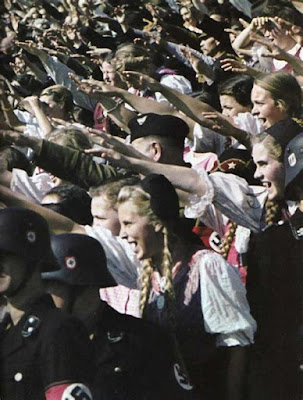 |
| American GIs letting themselves be filmed next to a victim of the Czechs |
 |
| LTC George Stevens of USASC pose with liberated German souvenirs |
Top screenshot: a young German prisoner of war smiles at the camera when receiving soup from an outdoor stove set up in the fields of Pilsen in Czechoslovakia on May 7 1945. This image is a photo still from film material taken by Swedish-American Capt. Oren W. Haglund who served with the American F.M.P.U. (First Motion Picture Unit). Fair use. Middle screenshot: American soldiers letting themselves be filmed next to a murdered ethnic German boy on the outskirts of Pilsen in Czechoslovakia on April 8 1945. Fair use. The following external links contains material not suitable for anyone under 18 years of age:
U.S. Army Footage Film. The film shows a long line of unarmed German POWs walking in the Böhmen countryside with fields on either side of the road on May 8 1945. Between 00:56 – 02:18 it shows armed White Russians from General Andrey Vlasov's Russian Liberation Army (ROA) who had enlisted into the Wehrmacht to fight against the Soviet Union. They later surrendered to U.S. forces near Pilsen but were all returned to the Soviets by the Americans. The camera crew inadvertantly stumbled on a village where reprisals had taken place by the local communist partisans prior to their arrival. Shots of surrendered German troops, individually beaten to death by the Czechs, lying on the grass. Some of the men are badly wounded but not yet dead. A dead body with blood on his face lies with Haglund's identifying slate beside his head. Several more shots of dead and severely wounded Germans. A half-naked man with blood on his face lies on the grass and looks at the camera. A group of American soldiers stand and look down at the corpse of a young boy in a German military coat. Various scenes with smiling Czech civilians, also seen is American film director and producer George Stevens posing with some
liberated souvenirs on May 2 1945. Stevens headed a film unit of the U.S. Army Signal Corps. The ultimate souvenirs was no doubt various insignia and decorations of the feared Waffen-SS. The SS cuff title that the man to the right in the bottom screenshot is wearing bears the inscription
Der Führer. Source: NARA. Producer: U.S. Army Air Force 4th CCU. More film material from F.M.P.U. at:
Critical Past. Warning extremely graphic. There were at least 15,588 documented killings of ethnic Germans committed by the Czechs after the end of World War II. German records show 18,889 confirmed deaths including 3,411 suicides. Czech records indicated 22,247 deaths including 6,667 unexplained cases or suicides. But the estimated number of missing Sudeten Germans in Böhmen-Mähren is by far much higher than the number of confirmed and documented deaths from violence. Edvard Beneš - president of Czechoslovakia, gave his fellow countrymen absolution for all the expulsion, butchery and massacres committed against German prisoners of war, women, children and civilians in the Sudetenland or the Banat (including the burning of German children at Wenzelsplatz in Prague on May 20 1945).




























